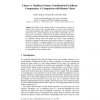Free Online Productivity Tools
i2Speak
i2Symbol
i2OCR
iTex2Img
iWeb2Print
iWeb2Shot
i2Type
iPdf2Split
iPdf2Merge
i2Bopomofo
i2Arabic
i2Style
i2Image
i2PDF
iLatex2Rtf
Sci2ools
DAGM
2006
Springer
2006
Springer
Linear vs. Nonlinear Feature Combination for Saliency Computation: A Comparison with Human Vision
In the heart of the computer model of visual attention, an interest or saliency map is derived from an input image in a process that encompasses several data combination steps. While several combination strategies are possible and the choice of a method influences the final saliency substantially, there is a real need for a performance comparison for the purpose of model improvement. This paper presents contributing work in which model performances are measured by comparing saliency maps with human eye fixations. Four combination methods are compared in experiments involving the viewing of 40 images by 20 observers. Similarity is evaluated qualitatively by visual tests and quantitatively by use of a similarity score. With similarity scores lying 100% higher, non-linear combinations outperform linear methods. The comparison with human vision thus shows the superiority of non-linear over linear combination schemes and speaks for their preferred use in computer models.
| Added | 22 Aug 2010 |
| Updated | 22 Aug 2010 |
| Type | Conference |
| Year | 2006 |
| Where | DAGM |
| Authors | Nabil Ouerhani, Alexandre Bur, Heinz Hügli |
Comments (0)

